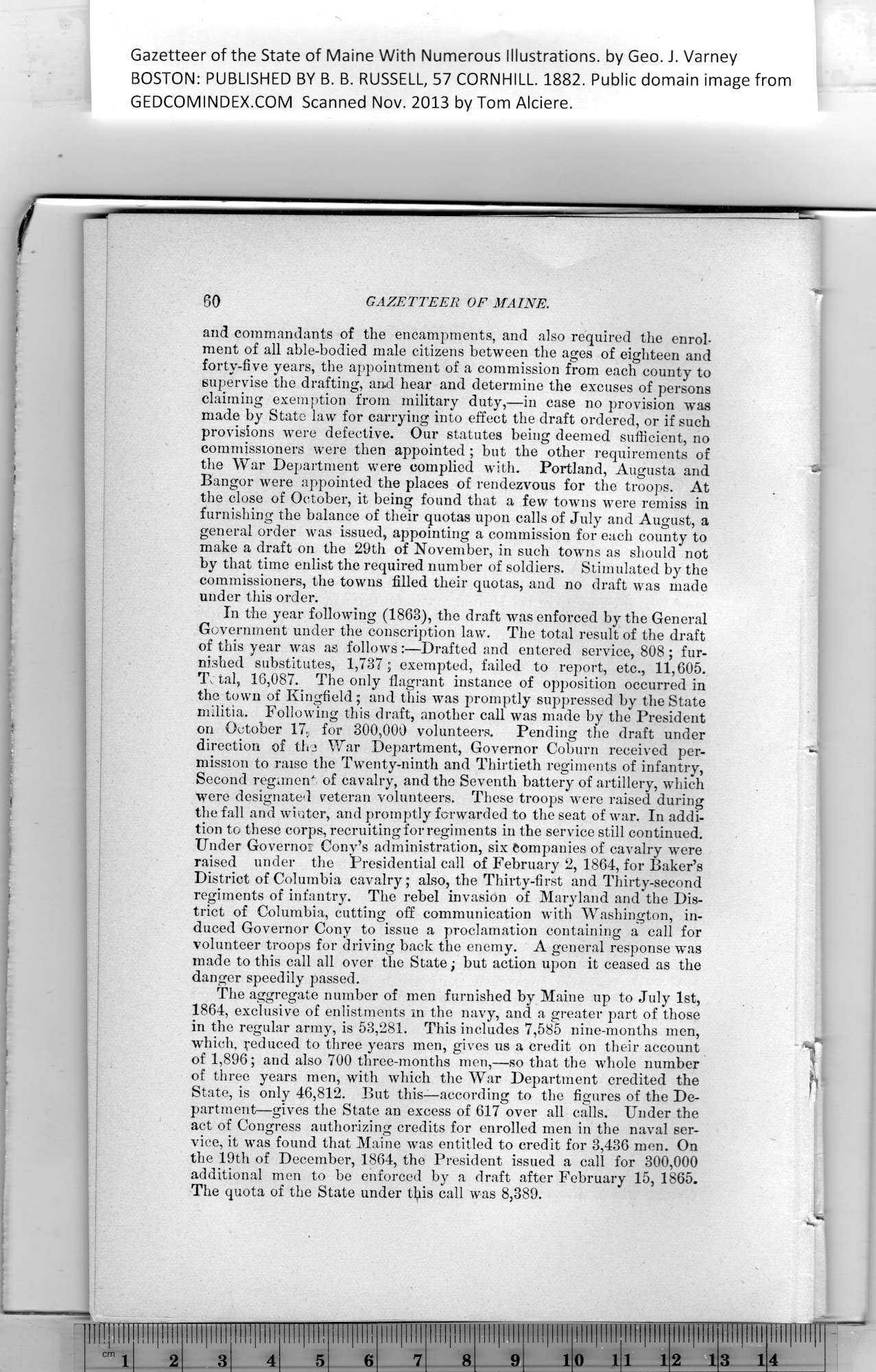|
Gazetteer of the State of Maine With Numerous Illustrations, by Geo. J. Varney
BOSTON: PUBLISHED BY B. B. RUSSELL, 57 CORNHILL. 1882. Public domain image from
60 GAZETTEER OF MAINE.
and commandants of the encampments, and also required the enrol-
ment of all able-bodied male citizens between the ages of eighteen and
forty-five years, the appointment of a commission from each county to
supervise the drafting, and hear and determine the excuses of persons
claiming exemption from military duty,—in case no provision was
made by State law for carrying into effect the draft ordered, or if such
provisions were defective. Our statutes being deemed sufficient, no
commissioners were then appointed ; but the other requirements of
the War Department were complied with. Portland, Augusta and
Bangor were appointed the places of rendezvous for the troops. At
the close of October, it being found that a few towns were remiss in
furnishing the balance of their quotas upon calls of July and August, a
general order was issued, appointing a commission for each county to
make a draft on the 29th of November, in such towns as should not
by that time enlist the required number of soldiers. Stimulated by the
commissioners, the towns filled their quotas, and no draft was made
under this order.
In the year following (1863), the draft was enforced by the General
Government under the conscription law. The total result of the draft
of this year was as follows:—Drafted and entered service, 808 ; fur-
nished substitutes, 1,737; exempted, failed to report, etc., 11,605.
Tctal, 16,087. The only flagrant instance of opposition occurred in
the town of Kingfield ; and this was promptly suppressed by the State
militia. Following this draft, another call was made by the President
on October 17, for 300,000 volunteers. Pending the draft under
direction of the War Department, Governor Coburn received per-
mission to raise the Twenty-ninth and Thirtieth regiments of infantry,
Second regiment of cavalry, and the Seventh battery of artillery, which
were designated veteran volunteers. These troops were raised during
the fall and winter, and promptly forwarded to tbe seat of war. In addi-
tion to these corps, recruiting for regiments in the service still continued.
Under Governor Cony’s administration, six Companies of cavalry were
raised under the Presidential call of February 2, 1864, for Baker’s
District of Columbia cavalry; also, the Thirty-first and Thirty-second
regiments of infantry. The rebel invasion of Maryland and the Dis-
trict of Columbia, cutting off communication wdth Washington, in-
duced Governor Cony to issue a proclamation containing a call for
volunteer troops for driving back the enemy. A general response was
made to this call all over the State; but action upon it ceased as the
danger speedily passed.
The aggregate number of men furnished by Maine up to July 1st,
1864, exclusive of enlistmeuts m the navy, and a greater part of those
in the regular army, is 53,281. This includes 7,585 nine-months men,
which, reduced to three years men, gives us a credit on their account
of 1,896; and also 700 three-months men,—so that the whole number
of three years men, with which the War Department credited the
State, is only 46,812. But this—according to the figures of the De-
partment—gives the State an excess of 617 over all calls. Under the
act of Congress authorizing credits for enrolled men in the naval ser-
vice, it was found that Maine was entitled to credit for 3,436 men. On
the 19th of December, 1864, the President issued a call for 300,000
additional men to be enforced by a draft after February 15, 1865.
The quota of the State under this call was 8,389.
PREVIOUS PAGE ... NEXT PAGE
This page was written in HTML using a program written in Python 3.2
|
